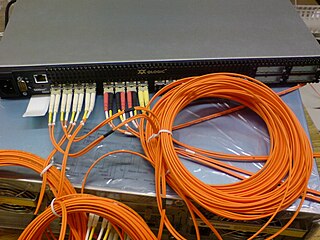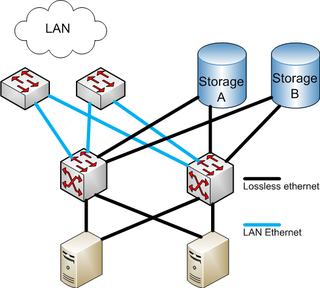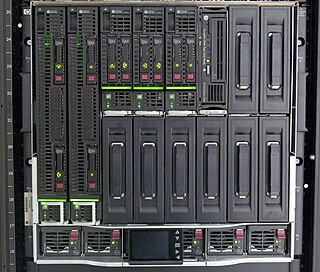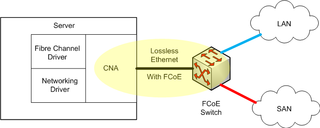Related Research Articles

InfiniBand (IB) is a computer networking communications standard used in high-performance computing that features very high throughput and very low latency. It is used for data interconnect both among and within computers. InfiniBand is also used as either a direct or switched interconnect between servers and storage systems, as well as an interconnect between storage systems. It is designed to be scalable and uses a switched fabric network topology. By 2014, it was the most commonly used interconnect in the TOP500 list of supercomputers, until about 2016.
Fibre Channel (FC) is a high-speed data transfer protocol providing in-order, lossless delivery of raw block data. Fibre Channel is primarily used to connect computer data storage to servers in storage area networks (SAN) in commercial data centers.

In computer hardware, a host controller, host adapter, or host bus adapter (HBA), connects a computer system bus, which acts as the host system, to other network and storage devices. The terms are primarily used to refer to devices for connecting SCSI, Fibre Channel and SATA devices. Devices for connecting to IDE, Ethernet, FireWire, USB and other systems may also be called host adapters.
A World Wide Name (WWN) or World Wide Identifier (WWID) is a unique identifier used in storage technologies including Fibre Channel, Parallel ATA, Serial ATA, SCSI and Serial Attached SCSI (SAS).

In the computer storage field, a Fibre Channel switch is a network switch compatible with the Fibre Channel (FC) protocol. It allows the creation of a Fibre Channel fabric, that is the core component of a storage area network (SAN). The fabric is a network of Fibre Channel devices which allows many-to-many communication, device name lookup, security, and redundancy. FC switches implement zoning, a mechanism that disables unwanted traffic between certain fabric nodes.
Brocade is an American technology company specializing in storage networking products, now a subsidiary of Broadcom Inc. The company is known for its Fibre Channel storage networking products and technology. Prior to the acquisition, the company expanded into adjacent markets including a wide range of IP/Ethernet hardware and software products. Offerings included routers and network switches for data center, campus and carrier environments, IP storage network fabrics; Network Functions Virtualization (NFV) and software-defined networking (SDN) markets such as a commercial edition of the OpenDaylight Project controller; and network management software that spans physical and virtual devices.

QLogic Corporation was an American manufacturer of networking server and storage networking connectivity and application acceleration products, based in Aliso Viejo, California through 2016. QLogic's products include Fibre Channel adapters, converged network adapters for Fibre Channel over Ethernet (FCoE), Ethernet network interface controllers, iSCSI adapters, and application-specific integrated circuits (ASICs). It was a public company from 1992 to 2016.
Internet Fibre Channel Protocol (iFCP) is a gateway-to-gateway network protocol standard that provides Fibre Channel fabric functionality to Fibre Channel devices over an IP network. It is officially ratified by the Internet Engineering Task Force. Its most common forms are in 1 Gbit/s, 2 Gbit/s, 4 Gbit/s, 8 Gbit/s, and 10 Gbit/s.

The IBM BladeCenter was IBM's blade server architecture, until it was replaced by Flex System in 2012. The x86 division was later sold to Lenovo in 2014.

Fibre Channel over Ethernet (FCoE) is a computer network technology that encapsulates Fibre Channel frames over Ethernet networks. This allows Fibre Channel to use 10 Gigabit Ethernet networks while preserving the Fibre Channel protocol. The specification was part of the International Committee for Information Technology Standards T11 FC-BB-5 standard published in 2009.

BladeSystem is a line of blade server machines from Hewlett Packard Enterprise that was introduced in June 2006.
Data center bridging (DCB) is a set of enhancements to the Ethernet local area network communication protocol for use in data center environments, in particular for use with clustering and storage area networks.

In computing, Linux-IO (LIO) Target is an open-source implementation of the SCSI target that has become the standard one included in the Linux kernel. Internally, LIO does not initiate sessions, but instead provides one or more Logical Unit Numbers (LUNs), waits for SCSI commands from a SCSI initiator, and performs required input/output data transfers. LIO supports common storage fabrics, including FCoE, Fibre Channel, IEEE 1394, iSCSI, iSCSI Extensions for RDMA (iSER), SCSI RDMA Protocol (SRP) and USB. It is included in most Linux distributions; native support for LIO in QEMU/KVM, libvirt, and OpenStack makes LIO also a storage option for cloud deployments.

The Dell blade server products are built around their M1000e enclosure that can hold their server blades, an embedded EqualLogic iSCSI storage area network and I/O modules including Ethernet, Fibre Channel and InfiniBand switches.

A converged network adapter (CNA), also called a converged network interface controller (C-NIC), is a computer input/output device that combines the functionality of a host bus adapter (HBA) with a network interface controller (NIC). In other words, it "converges" access to, respectively, a storage area network and a general-purpose computer network.
HP Virtual Connect brings virtualization to the blade server edge. It picks up where virtual machine technology stops. Virtual machine technology can only move workloads across virtual machines on a single server. It becomes a challenge when moving virtual machines from one physical machine to another or between data center locations because changes to the LAN and SAN environments require manual intervention by network and storage administrators. By pooling and sharing multiple network connections across multiple servers and virtual machines, Virtual Connect extends Data Center capability by allowing physical setup and movement of Virtual Machine workloads between servers and Virtual Machines, transparently from the LAN and SAN infrastructure. Another name for Virtual Connect is PowerConnect Switches.

SCST is a GPL licensed SCSI target software stack. The design goals of this software stack are high performance, high reliability, strict conformance to existing SCSI standards, being easy to extend and easy to use. SCST does not only support multiple SCSI protocols but also supports multiple local storage interfaces and also storage drivers implemented in user-space via the scst_user driver.
Dell PowerEdge VRTX is a computer hardware product line from Dell. It is a mini-blade chassis with built-in storage system. The VRTX comes in two models: a 19" rack version that is 5 rack units high or as a stand-alone tower system.
In an enterprise server, a Caching SAN Adapter is a host bus adapter (HBA) for storage area network (SAN) connectivity which accelerates performance by transparently storing duplicate data such that future requests for that data can be serviced faster compared to retrieving the data from the source. A caching SAN adapter is used to accelerate the performance of applications across multiple clustered or virtualized servers and uses DRAM, NAND Flash or other memory technologies as the cache. The key requirement for the memory technology is that it is faster than the media storing the original copy of the data to ensure performance acceleration is achieved.
Enterprise Storage OS, also known as ESOS, is a Linux distribution that serves as a block-level storage server in a storage area network (SAN). ESOS is composed of open-source software projects that are required for a Linux distribution and several proprietary build and install time options. The SCST project is the core component of ESOS; it provides the back-end storage functionality.
References
- ↑ Fibre Channel Industry Association Roadmap device speeds Archived 2012-11-27 at the Wayback Machine
- ↑ Brocade Advances Fibre Channel Innovation with New Fabric Vision Technology
- ↑ The Benefits of Brocade Gen 5 Fibre Channel
- ↑ Emulex Drives Gen 5 Fibre Channel Ecosystem with Partner Adoption
- ↑ LightPulse LPe16000B Gen 5 Fibre Channel PCIe 3.0 Single-Port Host Bus Adapter
- ↑ Q1 2014 QLogic Earnings Conference Call [ permanent dead link ]
- ↑ QLogic 2600 Series HBAs
- ↑ Brocade Launches Fabric Vision, Enhances Gen5 Portfolio — Tells the World Fibre Channel Is Still Hot March 26, 2013 - IDC Link
- ↑ "SAN Market Posts Strong Fourth Quarter, According to Dell'Oro Group". Archived from the original on 2013-05-29. Retrieved 2013-08-01.
- ↑ Brocade: People try to put us down, talkin' 'bout my (Fibre Chan) generation